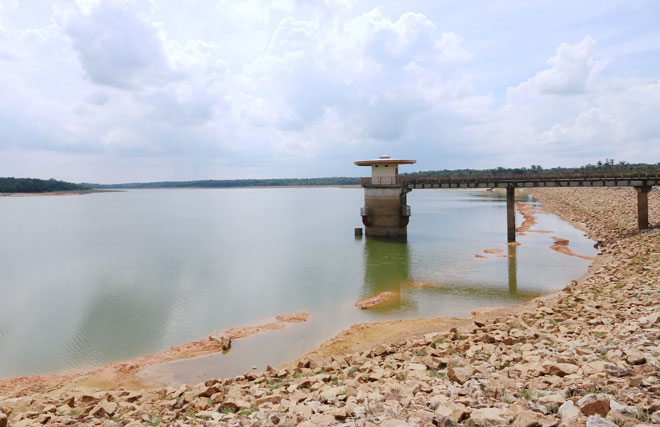
Sungai Layang Dam, Masai in Johor also not spared from the El Nino phenomenon as can be seen in this May 3 file photo. — Bernama photo
BATU PAHAT: A remapping of the types of water resources available in Johor needs to be done before any exploration of underground water source is conducted in the state government’s efforts to find long term alternative water resources in the state.
The move is in line with the state government’s efforts to draft a water supply development plan for 50 years, which is seen to solve the water problems faced due to the extreme and erratic global weather conditions lately.
Water and Environmental Engineering Department lecturer at the Faculty of Civil and Environmental Engineering, Universiti Tun Hussein Onn Malaysia (UTHM), Dr Mohamad Faizal Tajul Baharuddin said the remapping was required to get accurate data on potential sources for water.
“The last mapping by the Johor Department of Mineral and Geoscience was carried out over 15 years ago, and it was only the data for a particular area and not a comprehensive report. Therefore, it is appropriate to re-do the mapping to identify areas in the state where there is potential for underground water,” he told Bernama in an interview here recently.
Mohamad Faizal, who has eight years of experience in the exploration of underground water, had previously accompanied his Head of Department Dr Mohd Adib Mohammad Razi along with several other lecturers in the faculty to help several areas in Kelantan to tap underground water on a small scale, for the use of local residents.
“The remapping of water resources throughout Johor is estimated to take around six months, and could cost up to RM500,000,” he said.
According to him, the potential of underground water as a source was huge, as there was a very large quantity of clean water available, now expected to be in excess of what was once mentioned in studies by the Japan International Cooperation Agency (JICA).
In 1982, JICA reported that Malaysia was estimated to have about 5,000 billion cubic metres of underground water reserves, which remained untapped.
“However, our country up to now has used only three per cent of the total, which is mostly for small and medium industries, and agriculture activities like aquaculture,” said Mohamad Faizal.
Currently, only Kelantan uses groundwater resources as its main water source covering more than 70 per cent of the state, he said.
Mohamad Faizal said the groundwater management model run by Syarikat Air Kelantan Sdn Bhd (AKSB) should be reviewed and made into a ‘case study’, in addition to making improvements in terms of using more modern technologies, as well as the involvement of experts from within the country and abroad.
“For example, a well field in Kampung Putih, Kelantan, which has about 10 to 18 tube wells, is capable of delivering approximately 36,000 cubic metres of water per day to 3,000 to 5,000 people,” said the principal investigator at the Research Centre for Soft Soil at the university.
He said based on Johor’s terrain, groundwater resources were available through two of four types of aquifers that store water, namely alluvium, limestone, meta-sediment, and granite.
“In Johor, the groundwater resources are often found in soil near sandy beaches (alluvium) or meta-sediments. However, what’s important is to ensure the quality and quantity of underground water is good, exploration should be done deep into the ground, up to about 200 or 300 metres,” he said.
He added that in Kelantan, the exploration of underground water was done up to about 150 to 170 metres deep. Mohamad Faizal, however, acknowledged the cost of dredging was expensive, and that Malaysia did not yet possess the technology required to do it. Therefore, he said the development of local technology was very welcome.
Meanwhile Mohd Adib said UTHM had the expertise in terms of detecting potential underground water, and in this case, cooperation with foreign researchers could be beneficial not only to the state of Johor, but even the country.
Thus, both the lecturers concurred that the negative perception by certain parties towards underground water or its exploration as orthodox methods should be discarded, as it is still a viable and practicle solution. — Bernama
